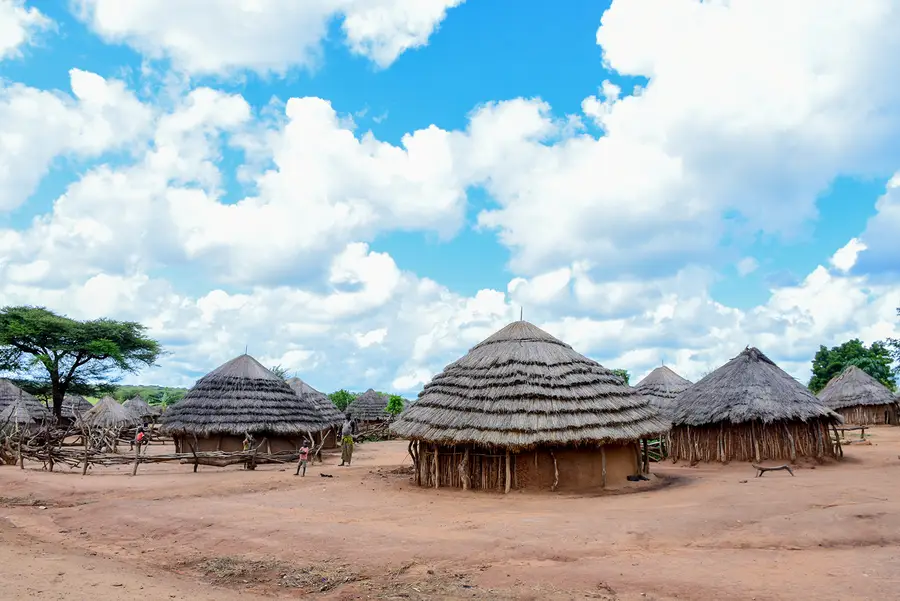
It’s a Monday in Amudat, which means it’s a market day in the Karamoja region of eastern Uganda. About a kilometer from the border with Kenya, a trading center attracts people from both countries — including many selling and trading animals. The area is home to the Karamojong and other nomadic pastoralist groups who depend on livestock for food and income, moving frequently with their animals for pastures and water.
Job Longolekon, a 30-year-old trader, relaxes to the side of the market. He has just taken medicines to prevent trachoma, a neglected tropical disease (NTD) that affects the eye and causes pain and blindness if left untreated. It’s not Job’s first time — he has participated in these mass treatment campaigns before — but he noticed this one was different.
“I was just on the Kenya side and I saw they are also treating for trachoma, which is different from before,” says Job.
For the first time, the Governments of Uganda and Kenya are coordinating the distribution of trachoma medicines on both sides of the border. It’s a historic achievement that culminates after years of coordination between the two governments, supported by partners like USAID’s Act to End NTDs | East program, led by RTI International, and the International Trachoma Initiative, who manages the donation of medicines from Pfizer.
As a trader of cows, sheep, and goats, Job crosses between the two countries frequently — making him part of a group of people that health officials in Uganda and Kenya don’t want to miss with treatment. Success in eliminating trachoma from the area depends on reaching as many people as possible, including nomadic pastoralist groups on both sides of the Uganda-Kenya border, until the illness is no longer a threat.
It’s a disease that Job knows all too well. He suffered from trachoma throughout his younger years, but it has resolved now that treatment has become readily available.
“I am happy with these programs because we avoid seeing blind people in the community,” says Longolekon. “There is change among the people after the treatment.”
Kenya and Uganda have seen tremendous success in their efforts to eliminate trachoma. But making steady progress in border communities has been tricky given the remote location, political and social dynamics, and how often people, many of whom are part of nomadic pastoralist groups, move around.
In Amudat district, Rodah Chepurai is one of the health volunteers giving out trachoma medicines in her community. She begins early in the morning — visiting homes, greeting and calling together household members, talking through medicine benefits and side effects, and then distributing the pills.
It’s not easy work.
“The distance of homes, moving under sunshine, hunger during the distribution, reaching homes and people are not there, and also explaining to people can be hard,” recounts Chepurai.
But she hopes that her efforts will have an even bigger impact this year.
“When both countries are giving medicines, most of the people will be treated,” she says. “This mass drug administration will ensure everyone is treated and it will stop the spread of the disease.”
She’s trying to reach people like John Lomaler. A cattle keeper, he is often travelling with his animals so it’s the first time he is receiving treatments for trachoma. “Sometimes we only receive medicines when they are brought to where we are,” says Lomaler.
And cattle keepers like John have become even harder to find in recent years. Harsh climates and frequent drought in the region have meant that the search for pasture takes them even farther to keep their animals fed.
And there’s Salome Cheposokong, a mother of two young children who crosses the border about once a week and doesn’t want to miss the annual distributions.
“I’m always happy with the treatment because it has helped the community, and especially the children, to recover from trachoma,” says Cheposokong. “Fewer people have been complaining of the disease since the treatment has been given.”
Coordinating these treatment campaigns is one critical part of a wider cross-border trachoma strategy between the two countries, which includes sharing data on disease prevalence, mapping border hotspots, and discussing progress on the use of the SAFE strategy.
Uganda’s Ministry of Health coordinates the country’s cross-border NTDs efforts, with support from the Act to End NTDs | East program. In Kenya, cross-border efforts are led by the Ministry of Health with support from The Fred Hollows Foundation, funded through the Sightsavers’ led Accelerate program.
To further help reach nomadic populations, Act | East is supporting targeted strategies and messages in these border districts and building relationships with organizations that can help reach nomadic groups.
Ultimately, cross-border work is key to both countries eliminating the disease by their 2030 target -- and to achieving a stronger, healthier East African region.
“We hope that no person will be found with trachoma in the future,” says Chepurai. “I help people to be healthy and when they are healthy, my family is also healthy.”







